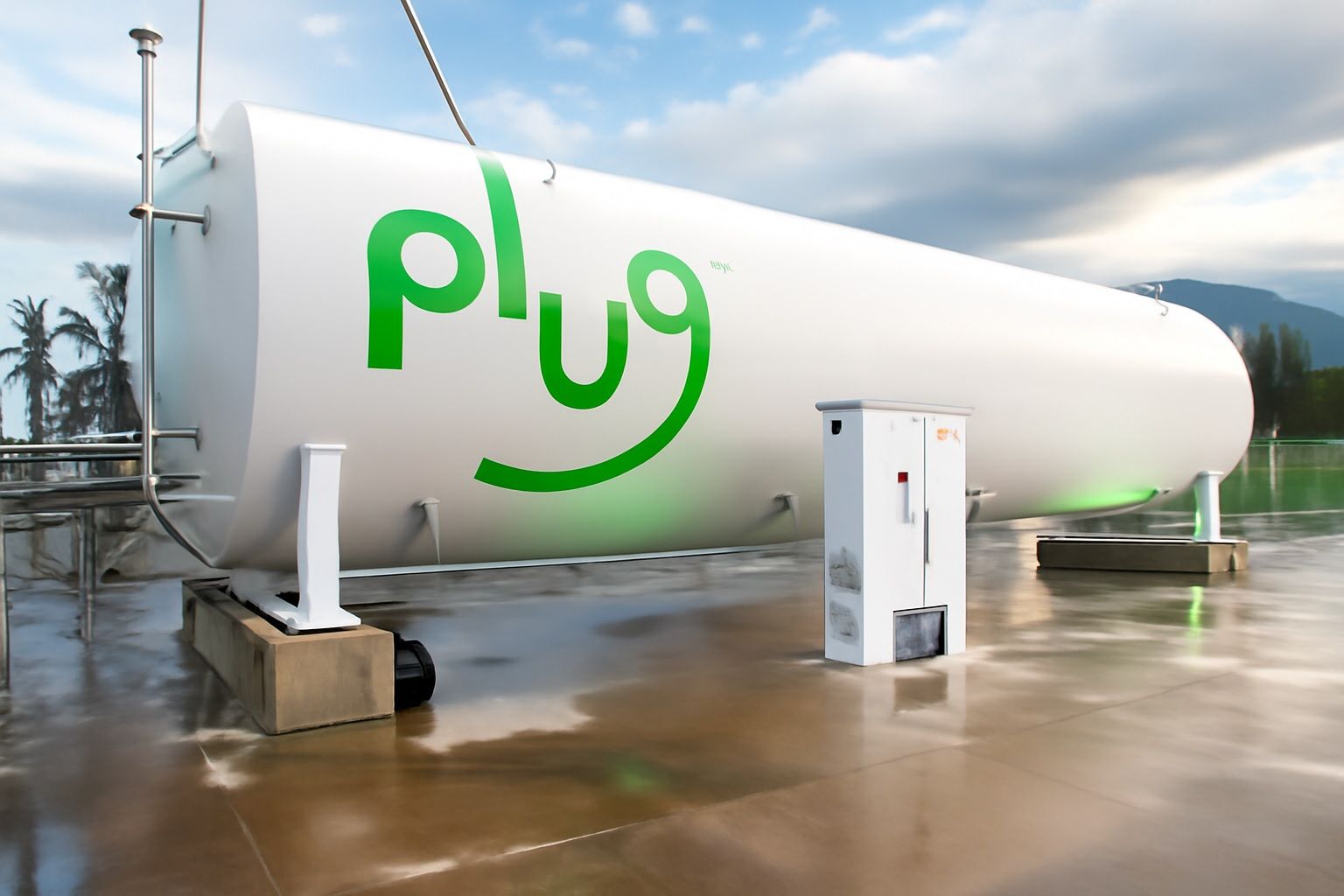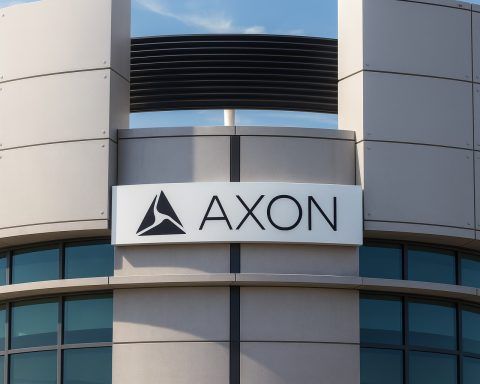- Current Price (Nov 2025): ~$2.7 per share, giving Plug Power a market capitalization around $2.9 billion [1] [2]. The stock has been extremely volatile – its 52-week range spans from a low of just $0.69 to a high of $4.58 [3]. Despite a sharp pullback in recent weeks, PLUG is still up roughly 25–30% year-to-date [4].
- Analyst Sentiment: Mixed “Hold.” Out of ~23 Wall Street analysts, only about 5 are bullish (Buy/Strong Buy) while 4 are outright bearish (Sell/Strong Sell), and the majority rate PLUG a Hold [5]. The average 12-month price target is in the mid-$2 range (around $2.3–$2.5), which is roughly in line with the current price [6]. Notably, there’s a huge disparity in expectations – highest analyst target about $7 and a lowest at just $0.75 [7] [8]. This reflects both optimistic and very pessimistic viewpoints on Plug’s future.
- Financials: Plug Power remains unprofitable. It reported a net loss of $227 million last quarter [9], and full-year 2025 earnings are expected to be deep in the red (analysts forecast –$0.59 EPS for 2026 as well) [10]. Cash burn has been heavy (free cash flow was approximately –$1 billion over the past year [11]), though management is working to reduce it. Revenues are growing (Q2 2025 sales were $174 million, +21% YoY [12]) and are projected around $700 million for 2025 [13], but profitability is still a few years away. Wall Street expects Plug to remain unprofitable until at least 2026, with cumulative negative free cash flow of about $2.5 billion through 2028 [14].
- Valuation & Targets: Given lack of profits, Plug is valued on revenue and future potential. At ~$2.7, it trades around 4.6× sales (P/S) which is higher than many industrial peers [15] [16]. Some analysts argue the stock price already factors in a lot of expected growth (the recent rally “baked in” most near-term optimism) [17]. For example, Clear Street research downgraded PLUG to Hold after a huge run-up, warning its valuation looked “stretched” with the stock near $3.90 [18]. The consensus view sees only modest upside (or even slight downside) from current levels in the near term [19].
- Key Drivers – Hydrogen Boom vs. Risks: Plug Power is a leading pure-play on hydrogen energy, which experts project to grow massively. Bloomberg NEF research forecasts demand for clean hydrogen could skyrocket 30× by 2030 [20] – a huge tailwind if it materializes. Plug has built an end-to-end green hydrogen business (from electrolyzers to fuel cells to refueling stations) and counts giants like Walmart, Amazon, Home Depot, BMW, and BP among its customers and partners [21]. However, the risks are high: Plug has a 25+ year history without profits, relies on substantial government subsidies (like the U.S. hydrogen Production Tax Credit) to make its products economically viable [22], and has diluted shareholders by issuing new stock to fund operations (share count nearly doubled in recent years) [23]. The stock also has heavy short interest (~30% of float), reflecting many investors betting against it [24]. This can fuel volatility – including dramatic short-squeeze rallies, but also sharp reversals.
- Recent Momentum: In mid-2025 Plug Power stock experienced a spectacular rally, surging over +250% from summer lows [25]. Positive news – like the delivery of a 100MW electrolyzer project in Europe and a bold analyst upgrade – sparked renewed optimism [26] [27]. One Wall Street firm (H.C. Wainwright) even raised its price target from $3 to $7, citing higher electricity prices and “growing regulatory support” for clean energy [28]. This bullish turn, combined with a short squeeze (short sellers rushing to cover positions), sent PLUG to a 17-month high of ~$4.58 by early October [29] [30]. However, the stock became technically overbought (14-day RSI > 80) [31] and has since pulled back about 40% from those highs. As of November, it trades in the mid-$2s – a reminder of its extreme volatility.
- Leadership & Shareholder Base: Plug Power’s CEO of 18 years, Andy Marsh, will step down in March 2026 (moving to an executive chairman role). A new chief executive (Jose Luis Crespo, currently a senior exec) is slated to take over during a pivotal growth phase [32]. This management transition introduces some uncertainty – Clear Street analysts caution about “transition risk” as the company executes its turnaround plan [33]. Institutional ownership is significant: major index funds like Vanguard and BlackRock each own ~8% of Plug [34], reflecting broad exposure. At the same time, insiders (management and directors) hold only ~1.4% of shares [35] and have done minimal buying recently, which could temper confidence. On a positive note, an existing large investor showed support by injecting $370 million cash into Plug in October via an early warrant exercise deal [36] [37] – boosting liquidity for growth, albeit at the cost of future dilution (the investor received new warrants at $7.75/share as an incentive) [38].
Recent Price Action and Technical Trends
Plug Power’s stock chart in 2025 tells a rollercoaster story. After languishing below $1 per share in mid-year, PLUG staged a stunning comeback in late summer and early fall. From August to early October, the stock rocketed from penny-stock levels to around $4.5 – fueled by bullish news and a classic short squeeze. (A short squeeze occurs when many traders who had bet against the stock rush to buy shares to cover their positions as the price rises, which in turn drives the price up even more [39].) Indeed, Plug’s short interest was near record highs – roughly 30% of its float (available shares) had been sold short [40] – so as the stock climbed, forced buying by shorts amplified the rally. In one week the stock jumped 60%, and it notched a ~250% gain over roughly five months [41] [42].
Momentum indicators flashed overbought by early October. For example, Plug’s 14-day RSI (Relative Strength Index) spiked above 80 (far above the typical 70 threshold), signaling the rally may have been overextended [43]. True to form, the peak around $4.58 proved short-lived. Profit-taking and fading hype set in after this euphoric run. Over the ensuing weeks, PLUG pulled back to the mid-$2s, giving up a large portion of its gains. In fact, October saw a ~28% decline for the stock [44], returning the RSI to more neutral levels.
From a chart perspective, support levels in the low-$2 range could be in focus – that’s roughly where the stock traded just before the breakout and is near the 50-day moving average. The 52-week low around $0.70 is a distant floor from earlier in 2025, while the recent high near $4.5 stands as major resistance. Trading volume exploded during the surge (at one point hitting four times the average daily volume) [45], which is often a sign of capitulation by shorts and speculative buyers piling in. As volume normalized, volatility also eased somewhat.
Overall, the technical picture shows a stock that can make outsized moves in short periods. Traders will be watching if Plug Power can hold above key psychological levels (like $2) and form a new base, or if further weakness will erase more of the 2025 rally. The recent cooldown may actually be healthy after an “overshoot” to the upside – the question is whether fresh catalysts will emerge to spark another leg higher, or if the stock will drift lower toward its pre-rally levels. Caution is warranted: Plug’s history is marked by spikes and steep drops, so risk management is important for those following technical trends.
Fundamentals and Industry Outlook
From a fundamental standpoint, Plug Power is a high-growth clean energy company operating in a nascent industry – green hydrogen – that has huge long-term potential but also significant current challenges. Let’s break down some key fundamental factors:
Revenue Growth and Operations: Plug’s business is growing rapidly in sales but still generating large losses. In Q2 2025, revenue was $174 million, up 21% year-over-year [46]. Notably, its hydrogen electrolyzer division (which makes equipment to produce green hydrogen) saw sales more than triple to $45 million in that quarter [47] – a sign that demand is ramping up for new hydrogen projects. The company also supplies fuel cell systems (e.g. for forklifts and warehouse vehicles) and hydrogen fuel services to big customers like Amazon and Walmart. These blue-chip clients have been betting on Plug’s technology to decarbonize their operations [48], providing a strong validation of Plug’s market opportunity.
Despite rising sales, Plug remains deeply unprofitable at present. The company’s net loss for Q2 was $236 million [49], and it lost over $700 million in 2024. However, margins are improving: gross margin in Q2 was –31%, which sounds poor but is a huge improvement from the –92% gross margin a year earlier [50]. This reflects cost-cutting and efficiency moves under “Project Quantum Leap,” Plug’s initiative to streamline operations. For example, management has reduced headcount and improved manufacturing processes, aiming to reach gross margin break-even by the end of 2025 [51] [52]. Plug’s CEO Andy Marsh highlighted that the company’s hydrogen plants in Georgia and Louisiana are now running reliably at scale, helping lower costs [53]. Better execution (fewer bottlenecks, more output) plus recent hydrogen supply agreements (locking in cheaper feedstock) are expected to yield substantial cost savings in the second half of 2025 [54].
Cash Burn and Capital: A critical concern is Plug Power’s cash burn. Building a hydrogen infrastructure empire isn’t cheap – the company has been spending heavily on new production facilities, equipment deployment, and R&D. Free cash flow has been deeply negative (around –$1 billion over the last 12 months [55]). The good news is that cash burn is improving: in the first half of 2025, Plug’s operating+investing cash outflow was down over 40% year-on-year [56]. For full-year 2025, analysts expect cash burn around $490 million, roughly half of 2024’s level [57]. The company is guiding that it can continue shrinking losses and even reach EBITDA breakeven by Q4 2026 [58] if all goes to plan.
To fund its operations until it turns cash-flow positive, Plug has had to raise capital frequently – often by issuing new stock, which dilutes existing shareholders. Indeed, as Morgan Stanley analysts pointed out, Plug’s share count has “nearly doubled” in recent years [59]. This dilution is an ongoing risk. However, the company recently took an inventive step to bolster its finances: in October 2025, Plug struck a deal with an institutional investor to exercise warrants early, netting $370 million in immediate proceeds [60]. In exchange, Plug granted that investor new warrants exercisable at $7.75 (a 100% premium to the stock price at the time) [61]. This deal improved Plug’s cash position considerably and, if the stock were to rise above $7.75 in the coming years, could bring in up to $1.4 billion more [62]. Essentially, one big investor showed confidence by injecting cash now (at $2/share) for the chance of bigger gains later – a positive sign, though it also means more potential shares outstanding if those high-price warrants ever get exercised.
Hydrogen Industry Tailwinds: Plug Power’s long-term bull case rests on the green hydrogen economy taking off. Hydrogen is seen as a critical solution for decarbonizing sectors that are hard to electrify (heavy transportation, industrial processes, energy storage, etc.). Forecasts for hydrogen growth are undeniably eye-catching. A Bloomberg New Energy Finance report projected that global demand for clean hydrogen could grow 30-fold by 2030 [63], and continue rising for decades after. Governments worldwide are backing hydrogen with policy support and funding. For example, the U.S. Inflation Reduction Act (IRA) introduced a production tax credit (PTC) of up to $3 per kilogram for green hydrogen [64], which essentially subsidizes companies like Plug to produce hydrogen at competitive costs. This 45V hydrogen PTC, along with a renewed 30% investment tax credit for fuel cell projects [65], is a game-changer for the economics of hydrogen. Plug’s CEO Andy Marsh called the IRA incentives “one big beautiful bill” for the industry [66]. In fact, Plug has already claimed these credits for its new plants and says the subsidies significantly improve project returns [67].
That said, the hydrogen revolution won’t happen overnight. Plug Power operates in an emerging market that is still highly dependent on policy support. As a Motley Fool analysis bluntly stated, “demand growth forecasts will be very sensitive to changes in government regulations and subsidies” – hydrogen isn’t yet cost-competitive with fossil fuels without help [68]. This means political shifts present a risk. For instance, in early 2025, a new U.S. administration attempted to pause or roll back some green energy funding (an executive order aimed at “terminating the Green New Deal”) [69]. While the hydrogen tax credits survived that attempt [70], the U.S. House of Representatives later even passed a bill that would eliminate the hydrogen PTC (nicknamed the “One Big Beautiful Bill”, ironically) [71]. That bill didn’t become law, but it underscores that policy uncertainty is hanging over the sector. Fortunately for Plug, by late 2025 there was more clarity – legislation was passed to extend the 45V hydrogen credits and solidify support for multiple years [72]. This long-term policy certainty should help both Plug and its customers plan investments with more confidence (no one wants to build a hydrogen plant if the subsidy might vanish next year).
Competition and Execution: Plug Power was an early mover and has built an impressive ecosystem, but it’s not alone. There are other fuel cell and electrolyzer companies (Ballard Power, Nel ASA, Bloom Energy, etc.), as well as industrial gas giants (Air Products, Linde) pushing into hydrogen. Plug’s strategy is to be a one-stop-shop for hydrogen solutions, and it has inked partnerships and joint ventures globally to expand its reach [73]. Still, the company’s execution track record has been a point of contention. Over the years, Plug sometimes overpromised and underdelivered on targets – something bears highlight. Morgan Stanley analysts have been skeptical, saying they have “reduced confidence in the company’s ability to execute on [its] strategy” without significant capital infusions [74]. They noted this back in 2023, warning of the need for dilutive raises – a warning that proved prescient given the subsequent equity issuance [75].
On a positive note, Plug is showing tangible operational progress recently. The output from its new hydrogen plants is ramping up, electrolyzer orders are rolling in, and gross margins are climbing out of a deep hole. The company also brought in new talent (the incoming CEO Jose Crespo, for example, and other managers) and restructured teams to sharpen execution. If Plug can hit its milestones – e.g. ~$1 billion revenue by 2026 and break-even shortly after – it would mark a dramatic turnaround toward a viable business model.
In summary, Plug Power’s fundamentals present a classic high-risk/high-reward profile. It sits at the intersection of a potentially transformational industry (green hydrogen) and the harsh realities of business (profitability, competition, funding). The upside is enormous if hydrogen adoption accelerates (given Plug’s leading position and integrated product lineup), but the downside is also significant if adoption stalls or if Plug fails to fix its finances in time. This dual nature is exactly what’s driving the wide split in analyst opinions and the stock’s volatility.
Bullish Case: Why PLUG Could Shine 🌟
Enthusiasts of Plug Power see it as a pioneer ready to benefit from a hydrogen revolution. The bullish thesis centers on growth, market leadership, and improving fundamentals. Here are the key points of the optimistic case:
- Explosive Market Growth & Market Leadership: The total addressable market for hydrogen is huge and expanding. As mentioned, clean hydrogen demand is expected to “skyrocket” in coming years [76]. If even a fraction of global decarbonization plans come to fruition, there will be massive demand for electrolyzers (to make hydrogen) and fuel cells (to use it) – products that Plug Power specializes in. Plug is often cited as a leader in this space, with a first-mover advantage. It has deployed over 70,000 fuel cell units and built 275 hydrogen fueling stations to date [77] – far more than most competitors. Bulls argue that this installed base and expertise give Plug a head-start to capture the coming green hydrogen wave. The company is essentially building a “green hydrogen ecosystem”, and its brand is well-known among customers seeking hydrogen solutions.
- Strong Revenue Growth and Path to Profitability: Plug’s sales growth remains robust (20%+ annually) and could accelerate as new projects come online. Analysts expect revenue to rise about 13% in 2025, 24% in 2026, and 22% in 2027 [78] – indicating an upward trajectory. Importantly, bulls point out that operational improvements are underway. The company has been cutting costs and improving efficiency, as evidenced by the big jump in gross margin from –92% to –31% year-on-year [79]. In the most recent quarter, management affirmed they are on track for key milestones like reaching gross margin breakeven by end of 2025 [80] and positive EBITDA by end of 2026 [81]. Achieving these would mark a turning point (“inflection point,” as one analyst put it [82]) toward a sustainable business model. Bulls believe that as losses shrink each quarter, investor confidence will grow and the stock will respond accordingly.
- Major Partnerships and Projects: Plug Power has secured partnerships with some of the world’s largest companies in e-commerce, retail, and energy. Amazon and Walmart, for instance, use Plug’s fuel cells in forklifts at their distribution centers, and both had multi-year supply agreements with Plug (Amazon even took an equity stake via warrants in the past). Furthermore, Plug is involved in large-scale hydrogen production projects, such as a 100MW electrolyzer deployment at a green hydrogen plant in Europe [83]. Each big reference project enhances Plug’s credibility and could lead to follow-on orders. In October 2025, the company announced it delivered a 10MW electrolyzer array to Galp’s refinery in Portugal, as part of a 100MW green hydrogen project – a significant commercial milestone [84]. Such wins suggest Plug’s technology is competitive and in demand. Bulls also highlight that “blue chip” investors have shown confidence – for example, the unnamed institutional investor who put $370 million into Plug via the warrant deal [85], or strategic investments from partners in Asia and Europe. This outside validation reinforces the bull case that Plug is on the right track.
- Government Policy as a Tailwind: Rather than fear subsidy dependence, bulls embrace it as a bridge to profitability. Generous government incentives (like the IRA credits in the U.S. and similar hydrogen funding in Europe) effectively lower the economic barriers for green hydrogen adoption. Plug’s CEO Andy Marsh has described the current policy environment as extremely favorable, recently telling Bloomberg he sees a “robust market” ahead for hydrogen and clean energy thanks to strong growth potential and government support [86]. Additionally, the U.S. Department of Energy is rolling out billions in grants for regional hydrogen hubs, and Plug Power is involved in multiple hub consortiums. If these hubs get built, Plug stands to supply equipment and services, boosting its revenues further. Bulls argue that as long as governments are pushing for a hydrogen economy (to meet climate goals and energy security needs), companies like Plug have a tailwind that will help them scale up and eventually drive costs down to where subsidies are no longer needed.
- Stock Momentum and Sentiment Shifts: Another element of the bull case is shifting sentiment. For much of 2022–2024, hydrogen stocks like PLUG were in a slump due to execution missteps and rising interest rates (which hurt speculative growth stocks). But 2025’s big rally showed that sentiment can flip quickly. In just a few months, Plug went from a forgotten penny stock to a retail trading darling again. Bulls believe this momentum can return. They note that short interest has started to decline (it fell from over 31% of float to ~29% recently, indicating some shorts have covered) [87]. Any further positive news – an earnings beat, a big new order, or faster cash-flow improvements – could trigger another wave of buying. When Plug has good news, the stock’s moves tend to be outsized (as seen with the 77% surge in one run after an electrolyzer project announcement and analyst upgrade) [88] [89]. Thus, bulls see significant upside potential. Some even throw out bold predictions: one Wall Street analyst (at Craig-Hallum) recently reaffirmed a Buy rating with a $4 target, saying shares have “137% upside” from late-September levels [90], while the most optimistic analyst (H.C. Wainwright) set a Street-high target of $7.00 [91]. If Plug executes well, bulls argue the stock could revisit those higher levels – implying a doubling or more from the current price over the next year.
In sum, the bullish case portrays Plug Power as a potential turnaround story at the forefront of a transformative industry. Yes, the company has stumbled in the past, but bulls believe the pieces are now falling into place: improving financial metrics, accelerating revenue from new products, supportive policy, and a massive market opportunity. Should these trends continue, they expect Plug’s stock to rally into year-end and beyond, perhaps outperforming the conservative analyst consensus. As one Motley Fool writer predicted, “Plug Power’s worst days could be over as its electrolyzer sales boom and hydrogen costs come down.” [92] In the best-case scenario, PLUG could reward investors with significant gains if it successfully rides the green hydrogen boom.
Bearish Case: Why Caution is Warranted ⚠️
On the flip side, skeptics of Plug Power have plenty of ammunition as well. The bearish case focuses on the company’s chronic losses, reliance on outside support, and the possibility that the recent hype is overblown. Key arguments from the bears include:
- Persistent Lack of Profit & Cash Drain: The number one concern is that Plug Power keeps losing money – and might continue to do so for the foreseeable future. Despite two decades of operations, the company has never achieved an annual profit. Bears point out that even with revenue growth, Plug’s costs remain very high. In the last reported quarter, it lost $0.40 per share [93] and had a net loss of ~$227 million [94], which is enormous relative to its quarterly revenue. The business model has yet to prove it can generate positive margins without subsidies. This raises the question: what if profitability is always “a few years away,” as it has been historically? Plug’s free cash flow is projected to stay negative through at least 2028, with an aggregate outflow of around $2.5 billion in the coming years [95]. Bears warn that this will necessitate further capital raises – meaning more debt or share dilution. They view the recent $370 million warrant-induced financing not as a one-off, but as a sign that Plug will continuously need fresh cash to fund its ambitions. If markets turn less friendly or the stock price stays low, raising capital could become harder, creating a risk to the company’s growth plans (or even its survival, in an extreme scenario).
- Valuation and Overvaluation Concerns: Even after the stock’s pullback, skeptics argue that PLUG’s valuation is hard to justify based on fundamentals. With a market cap near $3 billion and negative earnings, any valuation has to be based on future potential – and bears think the market might be far too optimistic in that regard. For example, after the recent rally that took the stock above $3.50, analysts at Clear Street downgraded it, saying the valuation had gotten “stretched” and that most good news was already priced in [96] [97]. The average analyst price target being below the current price (around $2.3 vs $2.7 market price) reflects this cautious outlook [98]. One concrete bearish signal: Morgan Stanley’s analysts rate PLUG Underweight (sell) and have a mere $0.75 price target on it [99] [100] – implying they expect the stock to lose three-quarters of its value. That $0.75 target is striking (and is the lowest on the Street), but it underscores a view that Plug’s shares could be significantly overvalued if the company cannot deliver the dramatic improvement that bulls expect. In short, bears feel the stock’s lofty story has run ahead of reality, and they highlight that even at ~$2.7, Plug is trading at a high multiple of its sales (over 4× next year’s revenue) while burning cash – a risky combo if growth slows or disappoints.
- Reliance on Government Subsidies and Policy Risk: As much as government support is a tailwind, bears see it as a crutch that masks the economics. Plug Power’s business viability, they argue, is largely propped up by subsidies like the $3/kg hydrogen credit. A MarketWatch piece noted that hydrogen fuel’s demand is “highly sensitive” to regulations and subsidies [101] – remove the support, and the demand could evaporate because green hydrogen is still more expensive than conventional fuels. Bears fear that political winds can change. For instance, if there’s a future administration or legislative push that rolls back clean energy incentives (not impossible, as evidenced by attempts in 2025 [102]), Plug’s economics could sharply deteriorate. Policy uncertainty in regions outside the U.S. is also a factor – Europe has been supportive but could impose stringent “additionality” rules on green hydrogen that make projects harder, and in other markets cheap natural gas or lack of carbon policy could hinder hydrogen adoption. In sum, the bears say Plug’s fortunes are too tied to government largesse. A company that can’t turn a profit on its own merits after decades, and needs constant subsidy, is not a sound investment in their view.
- Execution Risks and Management Turnover: Skeptics emphasize Plug Power’s history of missed targets and the challenges of scaling a new energy business. The Morgan Stanley critique from 2023 was scathing: “We see significant risk around PLUG’s business model… [we have] reduced confidence in the company’s ability to execute on that strategy barring a potential dilutive capital raise.” [103] Unfortunately, this warning was borne out – Plug indeed had to issue a lot of stock subsequently [104]. Bears also note that the long-time CEO, Andy Marsh, is stepping aside in 2026, and the President (Sanjay Shrestha) abruptly resigned in late 2025 [105]. While new leadership might help, it also means a period of adjustment and uncertainty. Clear Street’s downgrade explicitly cited this “transition risk” around management changes [106]. It could be disruptive at a time when flawless execution is needed. Additionally, competitors are nipping at Plug’s heels – if Plug stumbles in delivering projects or controlling costs, rivals could seize market share in the fast-evolving hydrogen sector. The bearish view is that execution risk is very high given the complexity of Plug’s operations (multiple product lines, global projects, supply chain needs, etc.), and that any further setbacks (delays in new plant ramp-ups, cost overruns, customer project cancellations) could seriously undermine the stock.
- Share Dilution and Shareholder Unfriendly Moves: Bears also highlight how existing shareholders have been diluted and may continue to be. The company’s strategy of funding growth via share issuance means that even if the enterprise does well, each share’s claim on that success is shrinking. For instance, Plug’s share count went from roughly 500 million in 2020 to over 1 billion in 2025 [107], which drastically reduces per-share metrics. The recent warrant inducement deal, while bringing in cash, came at the cost of potentially adding 185 million more shares (if future warrants are exercised) [108] [109]. That’s roughly a 15% potential dilution hanging out there. If Plug needs to raise additional capital (which, given the negative $140 million net cash at Q2 2025 [110], seems likely at some point), it might do more secondary offerings or take on debt. Either can pressure the stock. In short, bears argue that even if you believe in hydrogen, Plug Power might not be the best vehicle for investment because the company’s habit of issuing equity means shareholders could see their stake value diluted over time. This has happened before and could happen again, effectively acting like a headwind on the share price.
To sum up the bearish case: Plug Power is seen as a high-risk story stock with fundamentals that don’t yet justify its valuation. The company is burning cash, dependent on subsidies, and must execute nearly flawlessly to meet rosy projections – a tall order. Wall Street’s skepticism is evident in the preponderance of Hold/Sell ratings and the fact that some analysts think the stock could plummet (the $0.75 target from Morgan Stanley is roughly 70% below the current price [111]). The negatives – unending losses, dilution, uncertainty – lead bears to recommend avoiding the stock or even betting against it. In the eyes of one such analyst, “Plug Power’s lack of profitability continues to concern analysts, and is something investors have to watch.” [112] The bearish camp believes that until Plug proves it can generate cash and thrive without constant aid, the stock may well underperform or suffer further declines.
Institutional and Insider Sentiment
Understanding who is buying or selling Plug Power can provide insight into market sentiment:
Institutional Investors: PLUG is widely held by institutions, partly because it’s included in many indexes and clean-energy ETFs. As of 2025, large index fund managers like The Vanguard Group and BlackRock each own on the order of 8% of Plug Power’s outstanding shares [113]. This indicates that major institutions have exposure, though often via passive index tracking. In total, over 300 institutions and hedge funds hold Plug shares in their portfolios [114]. Notably, one institutional investor stepped up recently to increase its stake – as discussed, a single large investor exercised warrants to buy ~$370 million worth of stock in October 2025 [115]. This vote of confidence (putting fresh capital directly into the company) was a bullish signal, suggesting that at least one big player believes in Plug’s long-term plan. Additionally, well-known clean energy focused funds (for example, those run by ARK Invest’s Cathie Wood) have at times been shareholders of Plug, viewing it as a disruptive innovation in the energy sector.
On the other hand, some institutional analysts are quite bearish, as we’ve seen with Morgan Stanley and others. Hedge fund sentiment appears divided. Data from 24/7 Wall Street noted that Plug was among stocks with very high short interest that had explosive moves [116] – implying many hedge funds were short PLUG during 2025 (and got squeezed on the way up). While some of those shorts likely closed positions after the price fell back from $4+, short interest is still around 29% of float [117], indicating a significant portion of the market (often hedge funds) remains positioned for decline.
It’s also worth noting that Plug’s stock is part of thematic ETFs (like hydrogen economy ETFs or clean tech funds) which means institutional flows into/out of those funds can impact PLUG share price. In 2025, interest in “energy transition” investments has waxed and waned with oil prices and political developments. If sentiment toward clean tech improves broadly, ETFs may buy more Plug; if not, they could trim positions.
Insider Activity: Insiders (executives and directors) own only a small percentage of Plug Power – roughly 1.4% of shares are insider-held [118]. That’s fairly low, which could imply insiders don’t have huge skin in the game, though on the flip side the company has been around a long time and earlier insiders likely already cashed out portions. In the past few months, there’s no indication of significant insider buying – MarketBeat data shows $0 in insider share purchases vs about $17,000 in small sales over the last quarter [119]. Essentially, insiders neither heavily bought the dip nor sold large amounts during the rally (aside from routine planned sales). This neutral stance might suggest that management is cautiously optimistic internally but also acknowledges the risks (otherwise one might expect them to buy if they felt shares were clearly undervalued).
One big insider-related development is the leadership change: Andy Marsh (CEO) selling some shares over the years isn’t unusual for a long-tenured chief, but now that he’s transitioning out, investors will be watching if he sells more or if the new CEO buys stock as a sign of confidence. Also, the departure of President Sanjay Shrestha (who was a key executive) could have been interpreted negatively by some investors, though no direct insider trading red flag was associated with it.
Institutional Signals: Another metric, the consensus analyst rating, was covered above – institutions (banks and research arms) on average rate Plug a Hold, with a lean towards caution. At last count, Wall Street had 5 “Buy” or equivalent ratings vs 6 “Sell”/underperform ratings, and the rest neutral [120]. That consensus of “Hold” shows that institutional sentiment is lukewarm overall; there isn’t a strong bullish conviction from the analyst community at large.
However, within that, there are notable standouts: for example, H.C. Wainwright’s analyst is very bullish (Street-high target, as mentioned), whereas Morgan Stanley is very bearish. When analysts differ so much, it typically means the stock is controversial and perceptions vary based on different assumptions. It also means news flow (earnings, guidance, policy changes) can rapidly swing sentiment one way or the other.
In conclusion, the ownership and sentiment picture for Plug Power is mixed. Big institutions are in the name (some likely as passive holders, some as active believers in hydrogen growth), yet there is also significant short selling by those betting against the company. Insiders have not made dramatic moves, providing little extra insight. For a retail investor or observer, this split institutional stance suggests one thing: expect volatility. When a stock has both prominent bulls and bears among major players, it often reacts sharply to new developments as each side reassesses their thesis. Keeping an eye on changes in short interest, any insider buying (should it occur), or shifts in analyst tone (like new upgrades/downgrades) will be important to gauge where the “smart money” might be leaning as 2025 comes to a close.
Forecast Through End of 2025
With just weeks to go until the end of 2025, what can we expect for Plug Power’s stock? Given its recent swings and the cross-currents of news, short-term forecasting is tricky – but we can outline scenarios and a probable range based on current information:
- Bull Case Scenario (Year-End Rally): If Plug Power delivers positive news in its upcoming earnings (due November 10, 2025) or other year-end developments, the stock could regain momentum. For instance, a narrower-than-expected quarterly loss or a big new project announcement might rekindle investor enthusiasm. In a bullish scenario, PLUG might rebound toward the upper end of recent trading – perhaps testing the $4 level again (recall it hit ~$4.57 at its peak) if buying volume returns. Catalysts like a continued short covering, a favorable policy announcement (e.g. new hydrogen funding), or even general market rotation into beaten-down growth stocks could fuel a rally. Optimistic analysts point out that the stock has already more than doubled off its lows and could end the year on another upswing if sentiment shifts. Some projections from bulls see Plug “on the verge of a major comeback”, with one Motley Fool writer predicting the stock “could double by 2026” given surging electrolyzer revenues and cost cuts [121]. By end of 2025, a vigorous rally might put PLUG in a range of roughly $3.50 – $5.00, in the bull-case view. (This would assume exceptionally strong sentiment, akin to what we saw in early October.)
- Bear Case Scenario (Year-End Fizzle): On the other hand, if upcoming events disappoint – say, Plug’s Q3 earnings show continued heavy losses or the company lowers its 2025 revenue guidance – the stock could slide further. In a bearish scenario, broader market weakness (perhaps due to economic or interest rate worries) could also pressure speculative names like PLUG. The stock might break below recent support around $2.50 and drift closer to the $1 – $2 range. Extremely bearish analysts (like Morgan Stanley with their $0.75 target) believe the stock has room to fall if the hype fades and fundamentals don’t improve fast enough [122]. While a drop back to penny-stock territory by year-end seems unlikely absent a major negative shock, it’s not impossible if there were to be a severe miss or a market-wide selloff. More reasonably, the bearish year-end range might be around $1.50 – $2.50, which would still be above the year’s lows but far below the recent highs.
- Base Case (Stabilization around Current Levels): The most likely outcome from current vantage could be a middle ground: the stock consolidates around the current mid-$2s as the year closes. With the big catalysts (rally and pullback) now past, PLUG may hover in a relatively stable band unless jolted by news. The average analyst target of ~$2.36 [123] essentially predicts little change from here – implying the market has incorporated known information. Plug Power might trade range-bound, perhaps between roughly $2.00 and $3.00 through December, as bulls and bears remain in stalemate waiting for more data (like the early 2026 outlook, which the company will likely discuss in its next earnings call). This scenario would see the stock ending 2025 not far from where it is now, reflecting the “hold” consensus. Such a range would align with the idea that near-term optimism is balanced by ongoing risks, keeping the price in check.
It’s important to remember that Plug Power is a volatile stock, and unforeseen developments can shift its trajectory quickly. For example, year-end is when portfolios are rebalanced – if fund managers decide to take profits from PLUG’s earlier run or harvest tax losses, that could create extra selling pressure (or buying, if they want exposure for 2026). Additionally, any updates on hydrogen legislation or macroeconomic shifts (interest rates, oil prices, etc.) could indirectly influence sentiment on clean energy stocks.
In weighing all the evidence and expert commentary, a reasonable forecast would be that Plug Power’s share price by December 31, 2025 will likely land in the low-to-mid single digits. More specifically, a range of roughly $2 to $4 is a fair handicap barring extreme news. Hitting the upper end (toward $4) would probably require the company to surprise positively on execution or for the market to turn very bullish on growth stocks. Conversely, dipping to the lower end (near $2 or below) could happen if results disappoint or if recession fears make investors risk-averse. The consensus outlook leans toward the cautious side – as noted, the average analyst target is around $2.3 [124] and the majority have a hold/neutral stance. That suggests that, absent game-changing news, the stock may not stray dramatically from current levels in the immediate term.
Bottom Line: Plug Power’s stock has the capacity for big moves, but expecting a return to its October peak (>$4) by year-end may be optimistic unless we see very strong news. Likewise, a collapse to new all-time lows (<$1) appears unlikely given the recent fundamental improvements and support from hydrogen initiatives, although downside into the $1s is not off the table if market conditions sour. Investors should brace for continued volatility and keep an eye on key year-end events – notably the Q3 earnings report and any guidance on 2026 targets – which will heavily influence PLUG’s finish for 2025. In summary, a prudent forecast is that Plug Power will trade roughly flat to modestly higher by the end of 2025, with a year-end price in the $2–$3 range unless a major catalyst swings the narrative in the final stretch.
Sources:
- MarketBeat – Plug Power key stats, analyst ratings, price target & short interest [125] [126] [127]
- Investing.com (The Tokenist) – “Plug Power Stock: Catalysts Driving the Recent Rally” (analyst upgrades, short squeeze, technicals) [128] [129] [130]
- Motley Fool via Nasdaq – “Why Is Wall Street So Bearish on Plug Power? 1 Key Reason” (Morgan Stanley $0.75 target, subsidy reliance, dilution concerns) [131] [132] [133]
- Barchart via inkl – Analyst update on Clear Street downgrade and Plug’s Q2 2025 performance (valuation stretched, CEO transition risk, revenue $174M +21% YoY, gross margin improvement, 2025 guidance) [134] [135] [136] [137]
- Simply Wall St News – “Plug Power Jumps… Does the Rally Signal Real Value?” (FCF –$1.03B, intrinsic DCF value, P/S ratio vs peers) [138] [139]
- Yahoo Finance News via StocksGuide – Motley Fool highlights (“stock more than doubled in six months, worst days could be over as electrolyzer sales boom” and contrasting analyst views on 1-year price) [140] [141]
- Plug Power Investor Relations – Press release Oct 2025: warrant inducement $370M raise, new warrants at $7.75 (financing details and partner names) [142] [143] [144]
- Bloomberg/MarketWatch – Hydrogen industry outlook (clean H₂ demand to grow 30x by 2030, quote on AI mania stock surge) [145] [146]
- S&P Global / Hydrogen Insight – Policy news (IRA hydrogen tax credit details, Trump-era risks, House bill to end 45V credit) [147] [148]
- MarketBeat Ownership data – Insider holding 1.41%, recent insider trading [149]; Yahoo Finance holders data [150].
References
1. www.marketbeat.com, 2. www.marketbeat.com, 3. www.marketbeat.com, 4. www.marketbeat.com, 5. www.inkl.com, 6. www.inkl.com, 7. www.nasdaq.com, 8. www.investing.com, 9. www.investing.com, 10. www.marketbeat.com, 11. simplywall.st, 12. www.inkl.com, 13. www.inkl.com, 14. www.inkl.com, 15. simplywall.st, 16. simplywall.st, 17. www.inkl.com, 18. www.inkl.com, 19. www.marketbeat.com, 20. www.nasdaq.com, 21. www.globenewswire.com, 22. www.nasdaq.com, 23. www.nasdaq.com, 24. www.marketbeat.com, 25. www.alphaspread.com, 26. www.nasdaq.com, 27. www.nasdaq.com, 28. www.investing.com, 29. www.alphaspread.com, 30. www.alphaspread.com, 31. www.investing.com, 32. www.inkl.com, 33. www.inkl.com, 34. simplywall.st, 35. www.marketbeat.com, 36. www.globenewswire.com, 37. www.globenewswire.com, 38. www.globenewswire.com, 39. www.alphaspread.com, 40. www.investing.com, 41. www.alphaspread.com, 42. www.alphaspread.com, 43. www.investing.com, 44. www.marketbeat.com, 45. www.investing.com, 46. www.inkl.com, 47. www.inkl.com, 48. www.globenewswire.com, 49. www.investing.com, 50. www.inkl.com, 51. www.investing.com, 52. www.inkl.com, 53. www.inkl.com, 54. www.inkl.com, 55. simplywall.st, 56. www.inkl.com, 57. www.inkl.com, 58. www.inkl.com, 59. www.nasdaq.com, 60. www.globenewswire.com, 61. www.globenewswire.com, 62. www.globenewswire.com, 63. www.nasdaq.com, 64. www.ir.plugpower.com, 65. fuelcellsworks.com, 66. fuelcellsworks.com, 67. www.ir.plugpower.com, 68. www.nasdaq.com, 69. www.spglobal.com, 70. www.spglobal.com, 71. www.hydrogeninsight.com, 72. www.inkl.com, 73. www.marketbeat.com, 74. www.nasdaq.com, 75. www.nasdaq.com, 76. www.nasdaq.com, 77. www.globenewswire.com, 78. www.fool.com, 79. www.inkl.com, 80. www.inkl.com, 81. www.inkl.com, 82. www.investing.com, 83. www.ir.plugpower.com, 84. seekingalpha.com, 85. www.globenewswire.com, 86. x.com, 87. www.marketbeat.com, 88. www.nasdaq.com, 89. www.nasdaq.com, 90. www.investing.com, 91. www.investing.com, 92. stocksguide.com, 93. www.marketbeat.com, 94. www.investing.com, 95. www.inkl.com, 96. www.inkl.com, 97. www.inkl.com, 98. www.inkl.com, 99. www.nasdaq.com, 100. www.nasdaq.com, 101. www.nasdaq.com, 102. www.hydrogeninsight.com, 103. www.nasdaq.com, 104. www.nasdaq.com, 105. www.inkl.com, 106. www.inkl.com, 107. www.nasdaq.com, 108. www.globenewswire.com, 109. www.globenewswire.com, 110. www.inkl.com, 111. www.nasdaq.com, 112. www.nasdaq.com, 113. simplywall.st, 114. www.marketbeat.com, 115. www.globenewswire.com, 116. stocksguide.com, 117. www.marketbeat.com, 118. www.marketbeat.com, 119. www.marketbeat.com, 120. www.marketbeat.com, 121. stocksguide.com, 122. www.nasdaq.com, 123. www.inkl.com, 124. www.inkl.com, 125. www.marketbeat.com, 126. www.marketbeat.com, 127. www.marketbeat.com, 128. www.investing.com, 129. www.investing.com, 130. www.investing.com, 131. www.nasdaq.com, 132. www.nasdaq.com, 133. www.nasdaq.com, 134. www.inkl.com, 135. www.inkl.com, 136. www.inkl.com, 137. www.inkl.com, 138. simplywall.st, 139. simplywall.st, 140. stocksguide.com, 141. stocksguide.com, 142. www.globenewswire.com, 143. www.globenewswire.com, 144. www.globenewswire.com, 145. www.nasdaq.com, 146. www.alphaspread.com, 147. www.spglobal.com, 148. www.hydrogeninsight.com, 149. www.marketbeat.com, 150. simplywall.st














